Let's make a FOOLPROOF vegan egg yolk using vegetables via reverse spherification. Not only do the yolks taste good, but this also makes a fun little science project to engage your kids/class/yourself!

Jump to:
🍳 Vegan Egg Yolk
Prior to going vegan, popping the egg yolk was the most gastronomically exciting event at any brunch I went to. I'm not alone in loving that experience, there is an entire subreddit dedicated to "putting an egg on it" with 200k+ members!
A few years later, we had dinner at Crossroads Kitchen where all the Yelp reviewers raved about the pasta carbonara that came with a vegan yolk (left, below). Within that same month, I also had an "egg" on my ramen at Ramen Hood (right, below). These experiences blew my mind!

I'll admit it sort of is a gimmick, and a successful one at that for both businesses—but for those of us who've been missing that yolk popping sensation... it's so satisfying! If you're not vegan, it can be a benevolent practical joke on your loved ones as long as you make sure they're not allergic to any of the ingredients. It could also be a fun weekend science project you can eat at the end!
Speaking of science, let's get into the specific molecular gastronomy technique we'll use to make our eggy weggs.
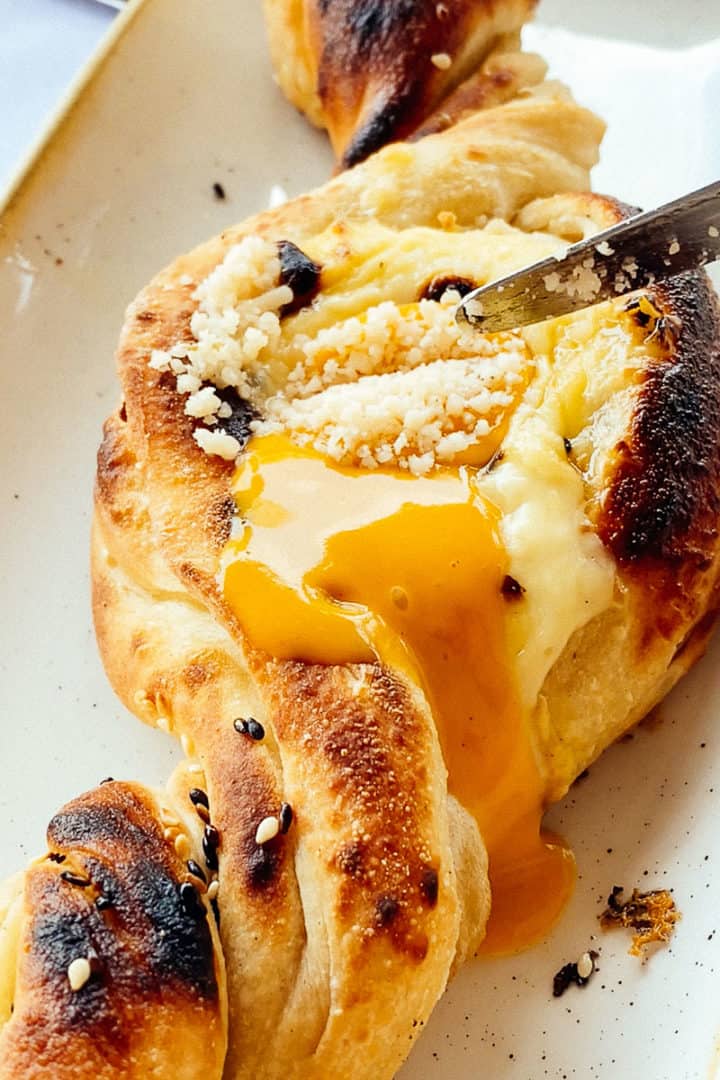
🧪 What is spherification?
Spherification is the molecular gastronomy technique of encasing liquid food in a thin polysaccharide membrane that can be popped. This encased liquid food could be pretty much anything you want it to be: juice, oils, pureed vegetables, boba pearl liquid, or vegan egg yolk!
There are two main methods used. Whichever type of spherification you use, the two main ingredients are always the same:
- Sodium Alginate
- Calcium Salt (Calcium Lactate OR Calcium Lactate-Gluconate OR Calcium Chloride)
Here's how Kitchen Theory describes the science behind spherification: "In the presence of calcium ions, a mixture containing sodium alginate forms a gel. The calcium ions insert themselves between individual alginate strands and will allow them to interlock and form a gel."
Isn't food science fascinating!?
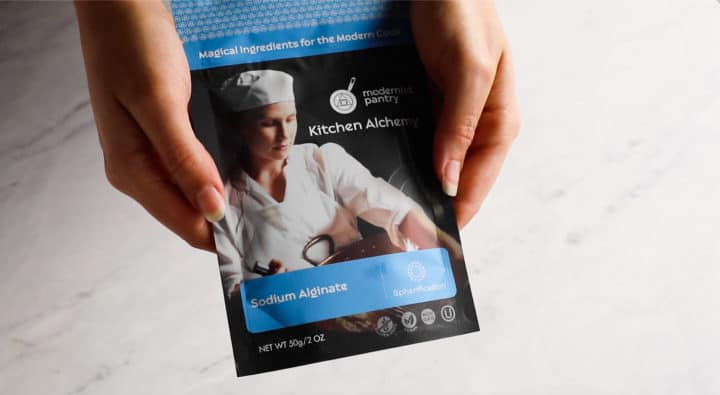
PS: There is another class of spherification that uses agar instead of sodium alginate. We're not covering this method at all. For further information on using agar for spherification, check out this resource.
Which type of calcium should you use for spherification?
Besides selecting the spherification method, choosing the type of calcium salt is the most important decision to make while attempting this project. These are the three main different types of calcium salts used in molecular gastronomy:
Calcium Chloride
This is often the cheapest and most widely available option. It is 36% calcium and is very soluble in water. There is one BIG caveat though: it tastes awful! So avoid it if you can.
Experts recommend using calcium chloride only in basic spherification and making sure to rinse the gelled food afterward. In case this is all you have access to, check out the double spherification technique below where you won't have to taste it as much.
Calcium Lactate
Calcium lactate tastes much, much better than calcium chloride and is often more expensive. It is 13% calcium and fairly soluble in room-temperature water. It is often used for reverse spherification.
While calcium lactate doesn't necessarily taste bitter or unpleasant, it still has that calcium-y flavor. Calcium-y is not a misnomer! Did you know that calcium is considered the sixth taste by some? After sweet, sour, salty, bitter, and finally, umami—scientists have reported receptors in our mouths that can detect calcium beyond its bitter or sour properties!
Calcium Lactate-Gluconate (or pure Calcium Gluconate)
Calcium gluconate is composed of 9% calcium and can be a lot more difficult and far more expensive to access than the other two calcium salts. The great thing about it is the taste... which is undetectable! It is often sold as calcium lactate-gluconate, which is a mixture of calcium lactate and calcium gluconate.
The verdict? Calcium lactate-gluconate is my preferred calcium salt for making vegan egg yolks.
Types of Spherification
There are two main types: basic and reverse. The third (basically using both types back to back) is a bonus method for those without access to non-bitter calcium salts.
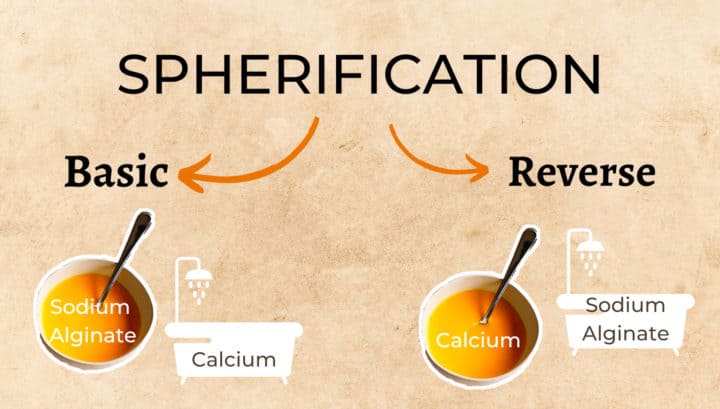
Basic Spherification
This method was invented first and is used to make ultra-thin membranes. Molecular gastronomy "caviar" is often made via this technique.
Sodium alginate (0.5%) is added to the flavored liquid and blended. The bath is prepared by mixing the calcium salt (1%) with water. A portion of the flavored liquid is dipped into the calcium bath in order to form a thin membrane. The encapsulated food is then dipped into water for a rinse.
The caveat? You can't encapsulate a liquid food that already contains calcium via basic spherification because the calcium in the flavored liquid reacts with the sodium alginate right away. Additionally, the pH level of the flavored liquid has to be above 3.6 to successfully use basic spherification.
Reverse Spherification
Chef Ferran Adrià of elBulli invented reverse spherification when trying to encase green olive "juice" to make little capsules that resemble real olives. Since its invention, most chefs prefer this method over the basic since they don't need to worry about the calcium content of the flavored liquid. Here's how:
The calcium salt (up to 2%) is added to the flavored liquid and mixed. The bath is prepared with a blend of sodium alginate (0.5%) and water. A portion of the flavored liquid is then dipped into the sodium alginate bath in order to form the membrane.
Using de-ionized water is ideal, but you don't need it for this home project. The egg yolks I made in a bath prepared with regular water came out just fine—no air bubbles!
Double Spherification
Many people reading this from outside the U.S. won't have easy access to calcium lactate or calcium lactate-gluconate. Calcium chloride is much easier to come by. Therefore, I wanted to share another way so that you too will still be able to create a delicious yolk without that bitter taste! This method is courtesy of Food & Story—I'd never come across double spherification before I read her article. It's ingenious.
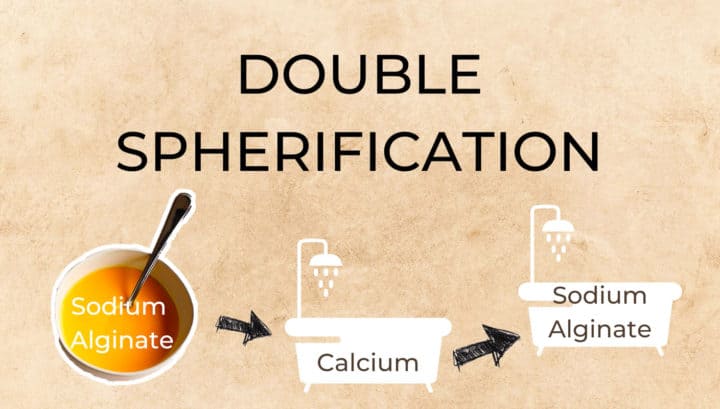
For double spherification, you add sodium alginate to the flavored liquid, create a calcium chloride bath, as well as a sodium alginate bath. Then you dip the flavored liquid first into the calcium bath, then the sodium bath. This way you get to have two polysaccharide membranes right on top of each other! So it creates something much stronger than either method on its own.
Why not simply use the "basic" method so that we're not adding calcium chloride into the flavored liquid? The membrane it creates is simply not strong enough. So technically we're using first the basic, then the reverse method of spherification back to back.
🥚 How to make foolproof vegan egg yolks
Ingredients
Besides sodium alginate and calcium lactate-gluconate, you will need a few other, and more "normal", ingredients:
Yellow / Orange Vegetable 🥕
This vegetable is what the end product will taste like, so pick one you enjoy! Crossroads Kitchen uses yellow tomatoes. In my experiments, the tomatoes tasted great. I also tested it with carrots since access to yellow tomatoes is often limited... those tasted great too! You could also use butternut or kabocha squash. I found sweet potatoes to be, well, a bit too sweet for this application.
Below photo has three yolks made with tomatoes, and two made with carrots. I can't tell them apart!

Because we're using reverse spherification, we don't need to worry about the calcium content or the acidity of this vegetable or any of the other yolk ingredients.
Olive Oil
Egg yolks are known to be fatty. To be exact, one real egg yolk gets nearly 56% of its calories from fat. We'll get somewhat close to that percentage using olive oil—no saturated fats or cholesterol involved!

Soy Milk
A real egg yolk gets about 34% of its calories from protein. To get to a similar percentage of protein in our vegan egg yolk, I used soy milk. If you're allergic or don't have any on hand, simply substitute with another plant-based milk or water.
Black Salt
This is the "secret ingredient" in many eggy vegan dishes you'll encounter. Black salt, or kala namak as is known in India, is a kiln-fired rock salt. It is pungent due to its sulfur content, which is exactly why we like to use it in egg substituting recipes like Turkish shakshuka or a simple tofu scramble.
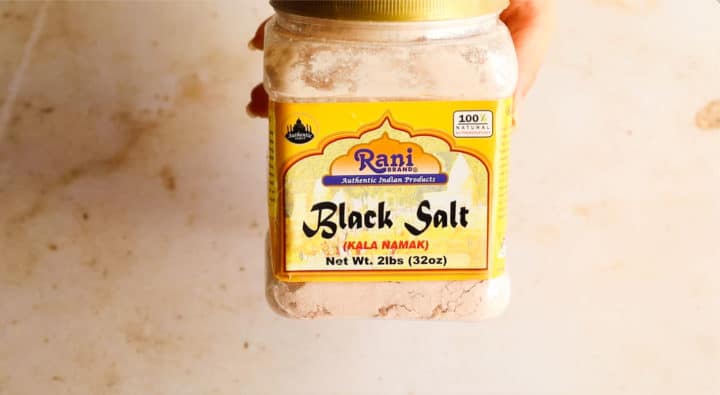
Just don't go overboard—a dash in more than enough and you could always add more if you'd like!
How to Make a Vegan Egg Yolk Step-by-Step
Prepare the Yolk Liquid
Roast (aka confire / confit) the tomato—or any other orange vegetable—in olive oil for 1 hour and 30 minutes at 325°F. Place the tomato along with its cooking liquids into a blender.
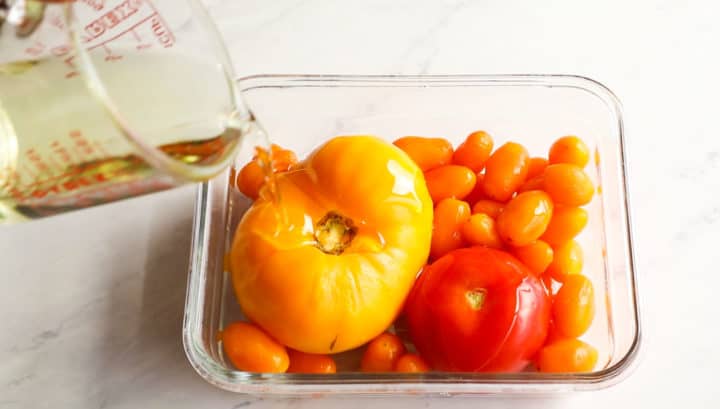
Add soy the soy milk, salt, and black salt. Blend and give it a taste. Adjust the seasoning if necessary. When you're satisfied with the taste, add the calcium lactate-gluconate into the blender and process for 1-2 minutes. Pour into an airtight container and set aside for a few hours or overnight.
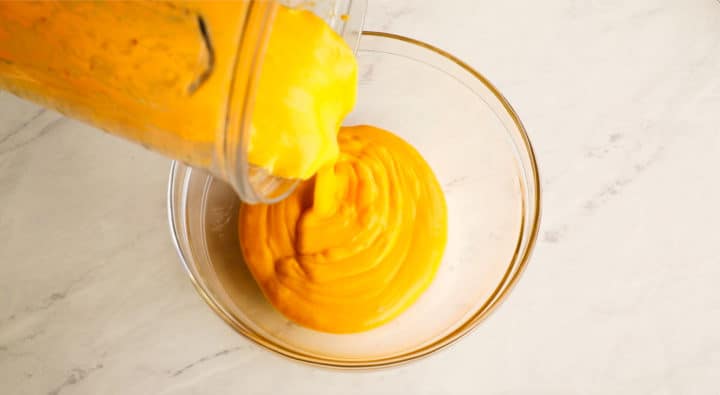
Prepare the Sodium Alginate Bath
Place the water and sodium alginate into a blender and process for 1-2 minutes. Set aside overnight in the refrigerator so that all the air bubbles surface and are eliminated.

*Don't forget to remove the alginate bath as well as the yolk liquid (if refrigerated) from the refrigerator at least an hour before using it to bring the bath back to room temperature.
Next Day: Make the Yolks
The finished product will take the shape of whichever utensil you use for dipping the liquid. A standard half-sphere tablespoon works great!
Pour the yolk liquid into the tablespoon, dip into sodium alginate for about a minute, then rinse and save in a water bath.

Alternative Method for Perfect Spheres
If you're after perfect half-spheres, try using a mold and freezing the base liquid! Chocolate truffle-sized molds that are about 1.5in in diameter are excellent for it.
After the yolk liquid has rested for a few hours, place into molds. Freeze, then dip into a warm (120°F) sodium alginate bath for about a minute. Rinse in water bath and save in water or vegetable oil. Watch this video by Chef Steps to see the frozen reverse spherification technique in action.
Adjust, Serve, or Save for Later
When the yolk is set and rinsed, test it. Is the popping satisfactory? If it's too thick, you can always add a bit more water to the yolk liquid and mix. In my experience, this didn't cause any air bubbles.
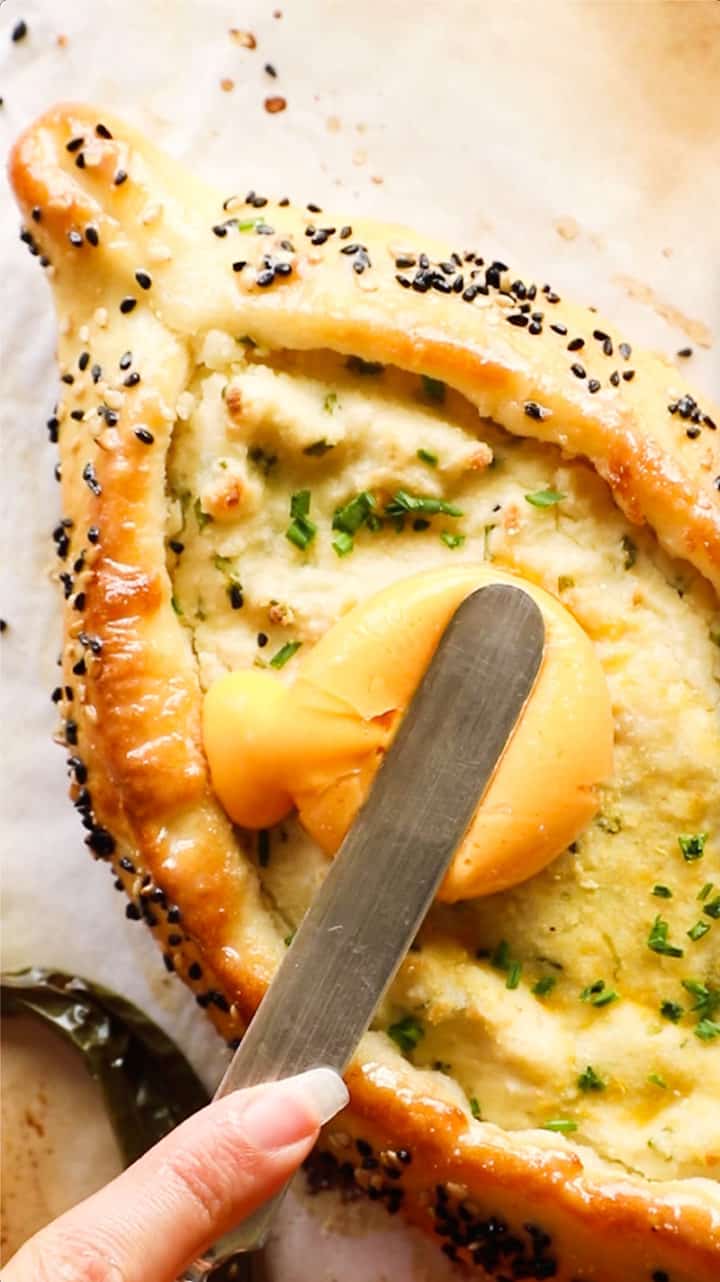
Keep the egg yolks in an airtight container filled with water or preferably olive oil for up to three days. Serve the yolk on avocado toast, pide, shakshuka, or rice!
📋 Tips for the best spherification results
For spherification beginners, here are a few tips that can help:
- Use a blender for mixing the ingredients to avoid clumps
- While dipped into the sodium alginate bath, rotate the yolks around to ensure a uniform membrane
- If the rinsing water bath has any visible particles floating around, remove with a sieve
- Don't forget to rest the sodium alginate solution overnight to remove air bubbles
- Bring the flavored liquid and the sodium alginate bath to room temperature before using
💭 Why would vegans want to eat eggs?
I see a version of this question all over the internet—it goes: why make vegan bacon/cheese/chicken/butter/steak/milk/egg yolk when you can have the real thing?
Because most people didn't "convert" to herbivores due to the bad taste of these animal-based foods. On the contrary, most vegans I know would admit they probably still taste as good as ever. It's just that they don't want to be a direct or indirect cause of suffering for animals to their best ability. The taste isn't the problem, the source of it is.
Let me give a quick example. Not to be a drag—but pretty much all male chicks are ground up alive during mass production of eggs... horrifying. But a vegan may still crave popping an egg yolk on their toast at breakfast. And that's okay. 🌱

🌱 Recipes to enjoy these egg yolks with
Here are some suggestions to #putaneggonit!
- Pide — my favorite way of enjoying egg yolks! 🍳
- Use it on vegan pasta recipes 😋
- Place onto servings of bean stew 🍲
- ...or simplify everything and go for an elevated avocado toast! 🥑
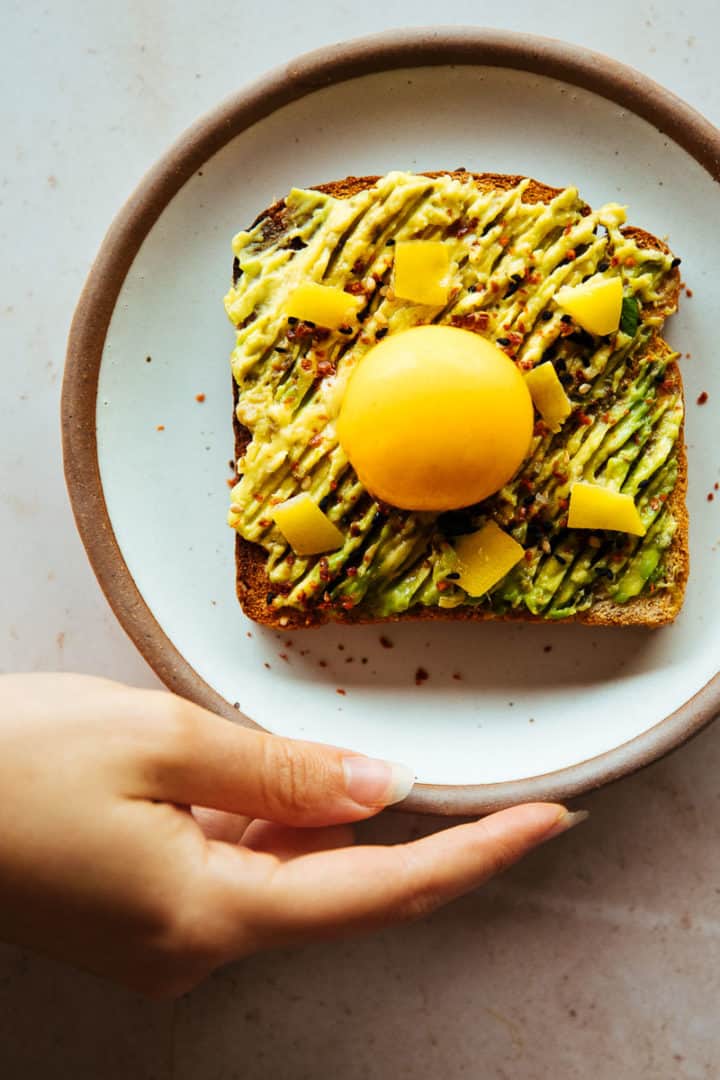
You can save this recipe for later on Pinterest, and keep in touch with me on YouTube, or Instagram!
Please do leave a comment & a rating if you make these vegan egg yolks! I make sure to respond to each one and it helps a ton. Afiyet olsun (bon appétit)!
Print📖 Recipe
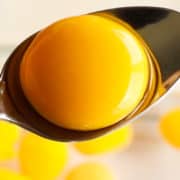
Foolproof Vegan Egg Yolk 🍳 - Using Spherification
- Total Time: 25 hours
- Yield: 24 yolks 1x
- Diet: Vegan
Description
Let's make a FOOLPROOF vegan egg yolk using vegetables via reverse spherification. Not only do the yolks taste good, but this also makes a fun little science project to engage your kids/class/yourself!
Ingredients
VEGAN EGG YOLK LIQUID (1.5 cups yolk liquid—makes 24 yolks, 1 tablespoon each)
- 1 medium (~180g) yellow tomato (See Note 1)
- ¼ cup olive oil
- ¼ cup plant milk (unflavored)
- ¼ cup water
- 1 tsp (7g) calcium lactate-gluconate (See Note 2)
- ½ tsp table salt (or 1 tsp Kosher salt)
- dash of black salt / kala namak (~1/16 tsp)
SODIUM ALGINATE BATH
- 4 ¼ cups (1000ml) water
- 1 tsp (7g) sodium alginate
WATER BATH
- 4 ¼ cups (1000ml) water
Instructions
Day 1
Prepare the Yolk Liquid
- Roast the tomato in olive oil for 1 hour and 30 minutes at 325°F. When cooked, place the tomato along with its cooking liquids into a blender.
- Add the plant milk, water, salt, and black salt. Blend and give it a taste. Adjust the seasoning if necessary.
- Add the calcium lactate-gluconate into the blender and process for 1-2 minutes. Pour into an airtight container and set aside for a few hours or overnight.
Prepare the Sodium Alginate Bath
- Place the water and sodium alginate into a blender and process for a few minutes. Set aside overnight in the refrigerator so that all the air bubbles surface and are eliminated.
Day 2: Make the Yolks
- Remove the sodium alginate bath as well as the yolk liquid (if refrigerated) from the refrigerator at least an hour before using it to bring the bath back to room temperature.
- Pour the yolk liquid into a standard half-sphere tablespoon, dip into sodium alginate for about a minute, then rinse and save in a water bath. (See Note 3)
Adjust, Serve, or Save for Later
- When the yolk is set and rinsed, test it. Is the popping satisfactory? If it's too thick, you can always add a bit more water to the yolk liquid and mix.
- Keep the egg yolks in an airtight container filled with water or olive oil for up to three days. Serve the yolk on avocado toast, pide, shakshuka, or rice!
Notes
1. Orange Vegetables: You may easily substitute the 1 medium yellow tomato with a) 3 medium (~180g) peeled carrots or b) 1 cup of chopped butternut or kabocha squash. Sweet potato could work as well, but may be too sweet for this application. For all these substitutions, you may need to adjust the yolk liquid by adding more water.
2. Calcium Salt: Calcium lactate-gluconate is the gold standard for spherification in order to eliminate any bitter flavors. You may substitute it with calcium lactate. However, if all you have access to is calcium chloride, use the double spherification method shown in the recipe video—replacing the calcium lactate-gluconate in the yolk liquid with sodium alginate, and adding a calcium chloride bath right before the sodium alginate bath. Use the same amounts per original recipe (1 teaspoon / ~7g each).
3. Alternative Method for Perfect Spheres: If you're after perfect half-spheres, try using a mold and freezing the base liquid! Chocolate truffle-sized molds that are about 1.5in in diameter are excellent for it. After the yolk liquid has rested for a few hours, place into molds. Freeze, then dip into a warm (120°F) sodium alginate bath for about a minute. Rinse in water bath and save in water or vegetable oil. Watch this video by Chef Steps to see the frozen reverse spherification technique in action.
4. Watch the video to see the process in action! It shows the double spherification method, but the steps are quite similar. Starts at 4:57.
- Prep Time: 20 minutes
- Cook Time: 1 hour 30 minutes
- Category: Staples, Breakfast, Brunch, Lunch, Dinner
- Method: Spherification
- Cuisine: Universal


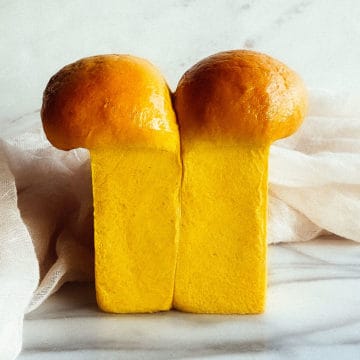
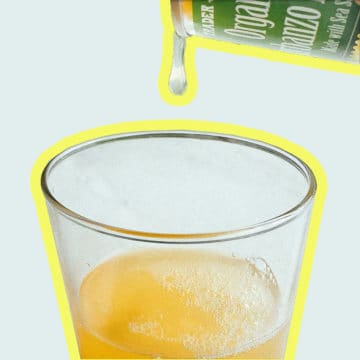
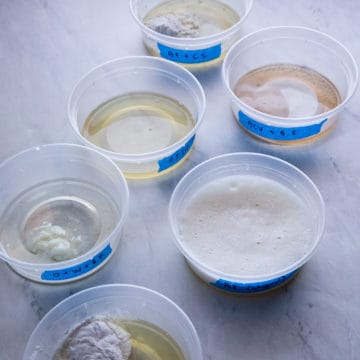

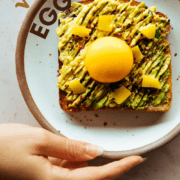

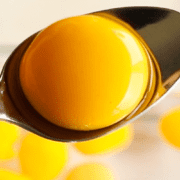
Rob
Made this last weekend with CLG and served on pasta. I appreciate the video and instructions, after two yolks it got much easier to shape them. The taste was really good too, used carrots. Thickness was just right. Overall it was super fun and I’ll be making spherified cocktails next.
Thanks for the inspiration!
Gönül
Thanks for taking the time to leave a review, Rob! I'm glad you enjoyed it!
Carl
Hi
Great idea !! How does one heat the yolks if need be .. without spoiling them ?
Thanks in advance 🙂
Carl
Gönül
Great question! 😀 I’ve never tried it to be honest… but if I did, would probably place them in warm water, kind of like poaching real eggs without using as much heat. Have you given it a try?
Karen
A bit fiddly at first but gets easier with a bit of practice! Tastes great and yes, you do get that satisfying pop!
Gönül
Thanks so much for your comment and review, Karen! Highly appreciated 🙂
Kelly Hayes
Good morning, I'm in the process of making these but have a question. For the yolks, ingredients state 1/4 cup soy milk and 1/4 cup water. Is that correct, or do you just use one or the other? In the description you only mention adding the soy milk (not the water). I don't want to mess this up! Thanks in advance,
Kelly
Gönül
Hi Kelly,
Add the 1/4 cup water as well as the soy milk. I'll update the instructions, thanks for pointing it out!
If the yolk liquid turns out too thick as you pop, you can always add more water to make it runnier.
Hope this helps!
Lara
This recipe really is something I have always hoped to find since going vegan! The only question is, is this yolk suitable to make vegan soy cured egg yolks?
Gönül
Glad to hear that! I'd assume it probably is not good for making soy cured egg yolks, though... 🙂
Emma
Fantastic ,worked perfectly!
Gönül
Yay! It’s a lot of fun, isn’t it? 🙂
Donna
Hey!! Can I make it without oil? Im thinking of using vegetable broth or aquafaba instead. Thanks a bunch
Gönül
I haven’t tried it without oil myself, but it could work! Let me know if you give it a try 🙂